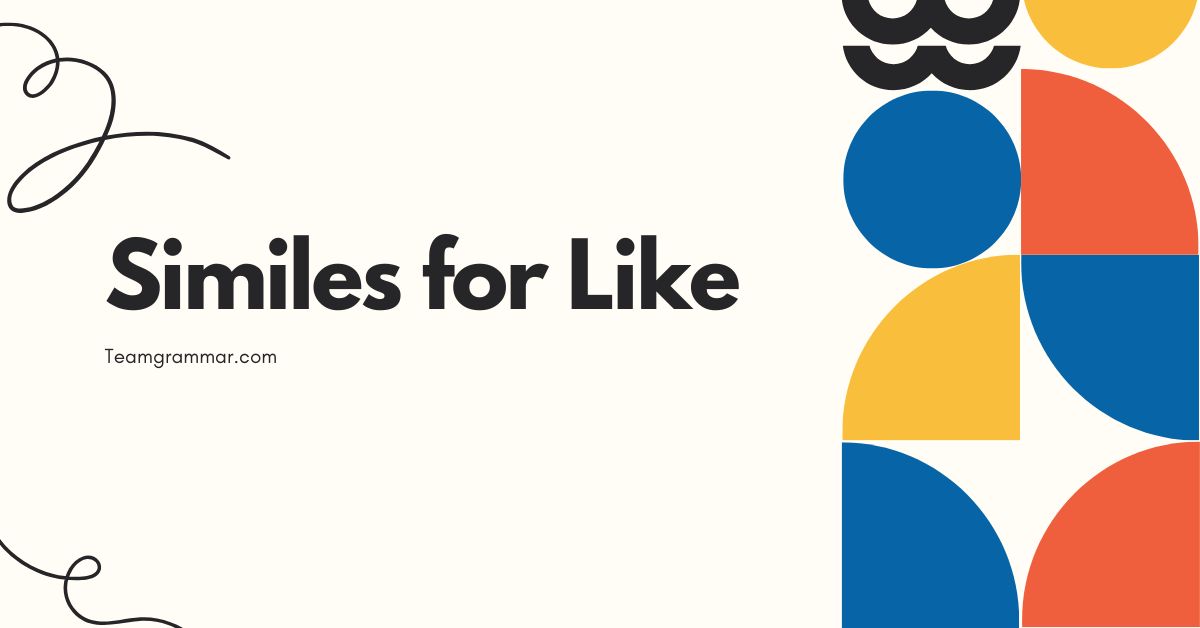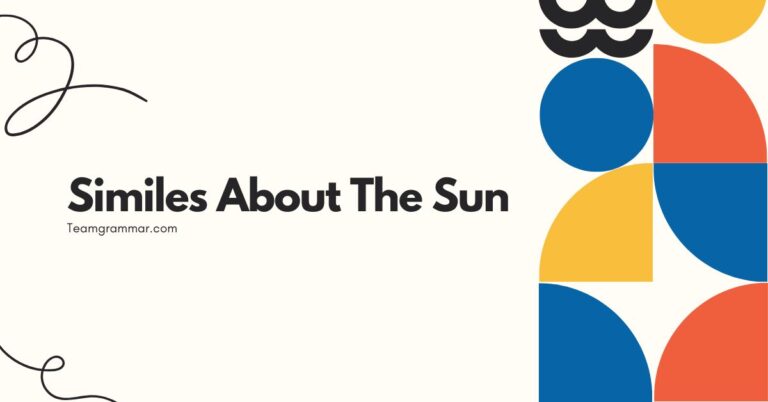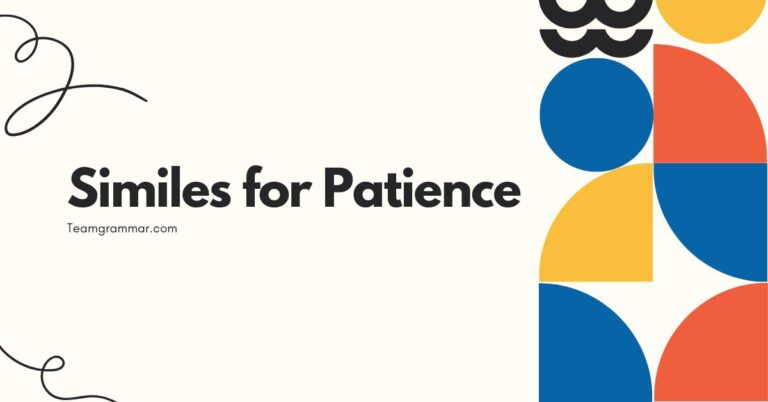33 Similes for Like: Enhancing Comparisons in English Grammar
Understanding similes is crucial for enriching your descriptive language skills. Similes, which use “like” or “as” to compare two unlike things, add vividness and depth to writing and speech.
This article explores various ways to create compelling similes, focusing on how to effectively use them to illustrate similarities and enhance communication. Whether you’re a student, a writer, or simply looking to improve your English proficiency, this guide will provide you with the knowledge and tools to master the art of simile creation.
This comprehensive guide will explore the nuances of simile construction, offering numerous examples and practical exercises. By delving into the structural elements, variations, and common mistakes associated with similes, you’ll gain the confidence to use them effectively.
This article aims to provide a clear and structured approach to understanding and applying similes in your everyday language use. Whether you’re aiming for creative writing or clear communication, mastering similes is a valuable asset.
Table of Contents
- Definition of Simile
- Structural Breakdown of Similes
- Types and Categories of Similes
- Examples of Similes
- Usage Rules for Similes
- Common Mistakes with Similes
- Practice Exercises
- Advanced Topics in Similes
- FAQ: Frequently Asked Questions About Similes
- Conclusion
Definition of Simile
A simile is a figure of speech that compares two unlike things using the words “like” or “as.” The primary function of a simile is to create a vivid and descriptive image in the reader’s or listener’s mind by highlighting a common characteristic between the two things being compared. Similes are a powerful tool in both literary and everyday language to make descriptions more engaging and understandable.
Similes are classified as figures of speech within the broader category of figurative language, which also includes metaphors, personification, and hyperbole. Unlike metaphors, which directly equate two things (e.g., “He is a lion”), similes explicitly acknowledge the comparison with “like” or “as” (e.g., “He is brave like a lion”).
This distinction is crucial in understanding the nuances of descriptive writing. Similes help to clarify and emphasize a particular aspect or quality by drawing a parallel to something familiar.
The context in which a simile is used can significantly impact its effectiveness. A well-chosen simile can enhance understanding and create a memorable image.
However, a poorly constructed or clichéd simile can detract from the overall impact. Therefore, careful consideration should be given to the appropriateness and originality of the comparison.
Similes are found in various forms of communication, including literature, poetry, advertising, and everyday conversation, making them a versatile and essential element of English grammar and rhetoric.
Structural Breakdown of Similes
The basic structure of a simile involves three key components: the subject being described, the linking word (“like” or “as”), and the object to which the subject is being compared. Understanding how these elements interact is essential for creating effective and meaningful similes.
The subject is the entity or concept that the simile aims to describe. It could be a person, place, thing, or abstract idea.
The linking word, either “like” or “as,” establishes the comparison between the subject and the object. The object is the entity or concept that shares a common characteristic with the subject, serving as a point of reference for the comparison.
The strength of a simile lies in the clarity and relevance of this comparison.
Consider the simile, “The snow was like a white blanket.” Here, “the snow” is the subject, “like” is the linking word, and “a white blanket” is the object. The simile effectively conveys the image of the snow覆盖ing everything in a soft, uniform layer, much like a blanket.
This structure allows for a clear and easily understandable comparison. Variations in simile structure can include the use of adjectives or adverbs to further refine the comparison, such as “as tall as a tree” or “runs like the wind.” These additions enhance the descriptive power of the simile.
Types and Categories of Similes
Similes can be categorized based on various criteria, including their function, complexity, and the nature of the comparison they make. Understanding these different types can help you choose the most appropriate simile for a given context and purpose.
Two primary categories aredescriptive similesandexplanatory similes.
Descriptive Similes
Descriptive similes focus on creating a vivid image or sensory experience for the reader. They often use comparisons that appeal to the senses, such as sight, sound, smell, taste, or touch.
These similes aim to evoke a specific feeling or impression by drawing a parallel between the subject and something familiar to the senses.
Explanatory Similes
Explanatory similes, on the other hand, aim to clarify or explain a concept by comparing it to something more understandable. They are often used to simplify complex ideas or processes by relating them to something that the audience is likely to be familiar with.
The goal is to enhance comprehension rather than to create a vivid image.
Other Categorizations
Similes can also be categorized by their level of complexity. Simple similes use straightforward comparisons, while complex similes may involve multiple layers of comparison or abstract concepts.
Additionally, similes can be classified based on their originality. Fresh, original similes are more impactful than clichéd or overused similes, which can lose their effectiveness over time.
Being mindful of these categorizations can help you craft similes that are both effective and engaging.
Examples of Similes
The following tables provide a wide range of examples of similes, categorized to illustrate their versatility and application in different contexts. These examples are designed to inspire and demonstrate the various ways in which similes can be used to enhance descriptive language.
Examples of Similes Using “Like”
This table presents examples of similes that utilize the word “like” to draw comparisons between different subjects and objects. Note how the word “like” is used to create a connection between the two elements, highlighting a shared characteristic.
| Simile | Explanation |
|---|---|
| The baby slept like a log. | The baby slept very soundly. |
| He eats like a horse. | He eats a large amount of food. |
| She sings like an angel. | She has a beautiful singing voice. |
| The car runs like a dream. | The car runs smoothly and efficiently. |
| The house looked like a palace. | The house was very large and luxurious. |
| His hands were like ice. | His hands were very cold. |
| Her eyes shone like stars. | Her eyes were bright and sparkling. |
| The rain fell like tears. | The rain was heavy and continuous. |
| The news hit him like a ton of bricks. | The news was shocking and overwhelming. |
| The crowd roared like a lion. | The crowd made a loud and powerful noise. |
| The old man’s face was wrinkled like a prune. | The old man had a very wrinkled face. |
| The runner moved like a cheetah. | The runner was very fast. |
| The child laughed like a hyena. | The child’s laughter was loud and unusual. |
| The politician acted like a puppet. | The politician’s actions were controlled by others. |
| The lake shimmered like a mirror. | The lake’s surface reflected light smoothly. |
| The desert stretched out like an endless sea. | The desert was vast and seemingly infinite. |
| The city skyline looked like a jagged mountain range. | The city’s buildings were tall and irregular. |
| The dancer moved like a feather in the wind. | The dancer’s movements were light and graceful. |
| The argument escalated like a wildfire. | The argument spread quickly and uncontrollably. |
| The project felt like climbing Mount Everest. | The project was challenging and arduous. |
| The computer screen glowed like a beacon in the dark. | The computer screen was brightly lit in a dark room. |
| The comedian’s jokes landed like lead balloons. | The comedian’s jokes were not well received. |
| His excuses sounded like a broken record. | His excuses were repetitive and unconvincing. |
| The tension in the room felt like a thick fog. | The tension in the room was palpable and heavy. |
| The old book smelled like musty attic. | The old book had a characteristic old and moldy smell. |
| The athlete’s determination was like an unyielding force. | The athlete was extremely determined. |
| The musician’s passion ignited like a flame. | The musician’s passion was intense and vibrant. |
| The detective’s mind worked like a well-oiled machine. | The detective’s thinking was efficient and precise. |
| The artist’s creativity flowed like a river. | The artist was very creative. |
Examples of Similes Using “As”
This table presents examples of similes that utilize the word “as” to draw comparisons between different subjects and objects. Observe how the word “as” is used to establish a parallel, emphasizing a shared quality or characteristic.
| Simile | Explanation |
|---|---|
| As brave as a lion. | Very brave. |
| As busy as a bee. | Very busy. |
| As cold as ice. | Very cold. |
| As light as a feather. | Very light in weight. |
| As quiet as a mouse. | Very quiet. |
| As strong as an ox. | Very strong. |
| As wise as an owl. | Very wise. |
| As stubborn as a mule. | Very stubborn. |
| As gentle as a lamb. | Very gentle. |
| As fast as lightning. | Very fast. |
| As clear as crystal. | Very clear. |
| As dark as night. | Very dark. |
| As dry as a bone. | Very dry. |
| As free as a bird. | Very free. |
| As good as gold. | Very well-behaved. |
| As heavy as lead. | Very heavy. |
| As innocent as a dove. | Very innocent. |
| As pale as a ghost. | Very pale. |
| As quick as a wink. | Very quick. |
| As red as a rose. | Very red. |
| As sharp as a tack. | Very intelligent or perceptive. |
| As smooth as silk. | Very smooth. |
| As tough as nails. | Very resilient or strong. |
| As vast as the ocean. | Very vast. |
| As warm as the sun. | Very warm. |
| As yellow as a lemon. | Very yellow. |
| As zealous as a convert. | Very enthusiastic. |
| As agile as a monkey. | Very agile. |
| As bitter as gall. | Very bitter. |
| As cunning as a fox. | Very cunning. |
Descriptive Similes Examples
This table provides examples of similes that are specifically designed to create vivid and sensory-rich descriptions. Notice how these similes appeal to the senses to enhance the reader’s or listener’s experience.
| Simile | Explanation |
|---|---|
| The sunset was as vibrant as a painting. | The sunset had brilliant and striking colors. |
| The music was like a soothing balm. | The music had a calming and comforting effect. |
| The air smelled as fresh as a mountain breeze. | The air was clean and invigorating. |
| Her laughter sounded like tinkling bells. | Her laughter was light and musical. |
| The fabric felt like velvet against her skin. | The fabric was soft and luxurious to the touch. |
| The city at night was like a glittering jewel box. | The city was bright and sparkling with lights. |
| The forest was as silent as a tomb. | The forest was eerily quiet. |
| The soup tasted like sunshine on a cold day. | The soup was warm and comforting. |
| The waves crashed like thunder against the shore. | The waves made a loud, booming sound. |
| The stars shone as bright as diamonds in the sky. | The stars were brilliant and sparkling. |
| The fog hung heavy, like a damp curtain. | The fog was thick and oppressive. |
| The dew on the grass sparkled like tiny diamonds. | The dew was bright and reflective. |
| The wind howled like a banshee in the night. | The wind made a loud, eerie sound. |
| The scent of cinnamon filled the air like a warm embrace. | The scent was comforting and inviting. |
| The old wooden floor creaked like an old man’s bones. | The floor made a noise that sounded aged and fragile. |
| The autumn leaves fell like confetti. | The leaves were colorful and scattered. |
| The moon was as round as a silver coin. | The moon was perfectly circular. |
| The coffee tasted like liquid heaven. | The coffee was exceptionally delicious. |
| The snow crunched underfoot like broken glass. | The snow made a sharp, brittle sound. |
| The honey was as sweet as nectar. | The honey was very sweet. |
| The mountain loomed like a sleeping giant. | The mountain was large and imposing. |
| The garden was as colorful as a rainbow. | The garden had a wide variety of bright colors. |
| The silence was like a heavy blanket. | The silence was oppressive and noticeable. |
| The rain pattered against the window like gentle fingers. | The rain made a soft, rhythmic sound. |
| The fire crackled like a mischievous spirit. | The fire made lively and unpredictable sounds. |
| The cake was as delicious as a dream. | The cake was exceptionally tasty. |
| The stars twinkled like distant fireflies. | The stars were small and flickering. |
| The river flowed as smoothly as liquid glass. | The river’s surface was calm and reflective. |
| The leaves rustled like whispered secrets. | The leaves made soft, mysterious sounds. |
Usage Rules for Similes
To effectively use similes, it’s important to adhere to certain usage rules. These rules ensure that your similes are clear, relevant, and impactful.
One fundamental rule is to ensure that the comparison is logical and meaningful.
The two things being compared should share a recognizable characteristic or quality. Avoid comparisons that are too abstract or far-fetched, as they may confuse the reader.
For example, “The idea was like a purple elephant” is not as effective as “The idea was as clear as crystal,” because the latter makes a more direct and understandable comparison.
Another important rule is to avoid using clichés. Overused similes, such as “as busy as a bee” or “as strong as an ox,” have lost their impact due to overuse.
Strive for originality by creating fresh and unique comparisons. Additionally, be mindful of the context in which you are using the simile.
The simile should be appropriate for the tone and style of your writing or speech. A formal context may require more sophisticated similes, while an informal context may allow for more playful or humorous comparisons.
Common Mistakes with Similes
One of the most common mistakes with similes is using them incorrectly or ineffectively. Here are some typical errors and how to avoid them, with correct and incorrect examples.
Mixing Up Similes and Metaphors: A common error is confusing similes with metaphors. Remember that similes use “like” or “as” to make a comparison, while metaphors directly equate two things.
| Incorrect | Correct | Explanation |
|---|---|---|
| He is like a lion (intended as a metaphor). | He is a lion (metaphor). He is brave like a lion (simile). | The incorrect example uses “like” but intends to convey a direct equivalence. |
Using Clichéd Similes: Overused similes can make your writing sound unoriginal and dull.
| Incorrect | Correct | Explanation |
|---|---|---|
| As busy as a bee. | As busy as Santa’s elves on Christmas Eve. | The correct example provides a fresh and more vivid comparison. |
Illogical Comparisons: Ensure that the comparison makes sense.
| Incorrect | Correct | Explanation |
|---|---|---|
| The car was like a banana. | The car was as yellow as a banana. | The incorrect example doesn’t provide a clear basis for comparison. |
Overusing Similes: While similes can enhance your writing, using too many can make it feel forced and unnatural.
| Incorrect | Correct | Explanation |
|---|---|---|
| The sun was like a golden coin, and the sky was like a blue canvas. The birds sang like angels. | The sun shone brightly in the blue sky, and the birds sang sweetly. | The correct example uses more direct descriptions to avoid overusing similes. |
Practice Exercises
These practice exercises are designed to help you reinforce your understanding of similes. Each exercise focuses on different aspects of simile construction and usage.
Complete the exercises to test your knowledge and improve your skills.
Exercise 1: Identifying Similes
Identify the similes in the following sentences. Underline the simile and identify the two things being compared.
| Question | Answer |
|---|---|
| 1. The moon was as round as a plate. | as round as a plate; moon and plate |
| 2. Her voice is like velvet. | like velvet; voice and velvet |
| 3. He ran fast. | No simile |
| 4. The snow sparkled like diamonds. | like diamonds; snow and diamonds |
| 5. The children were as quiet as mice. | as quiet as mice; children and mice |
| 6. The clouds were fluffy. | No simile |
| 7. The traffic moved like a snail. | like a snail; traffic and snail |
| 8. The cake tasted like heaven. | like heaven; cake and heaven |
| 9. She is very kind. | No simile |
| 10. The building was as tall as a skyscraper. | as tall as a skyscraper; building and skyscraper |
Exercise 2: Completing Similes
Complete the following similes by filling in the missing word or phrase.
| Question | Answer |
|---|---|
| 1. As tall as a _____. | tree |
| 2. Like a _____ in the wind. | feather |
| 3. As cold as _____. | ice |
| 4. Sleeps like a _____. | log |
| 5. As bright as the _____. | sun |
| 6. Moves like a _____. | shadow |
| 7. As sweet as _____. | honey |
| 8. Shines like a _____. | star |
| 9. As fierce as a _____. | lion |
| 10. Feels like _____. | velvet |
Exercise 3: Writing Your Own Similes
Write a simile for each of the following subjects.
| Subject | Answer |
|---|---|
| 1. The ocean | The ocean was as vast as the imagination. |
| 2. A smile | A smile is like sunshine on a cloudy day. |
| 3. A book | A book is like a portal to another world. |
| 4. Time | Time flies like an arrow. |
| 5. Fear | Fear is like a shadow that follows you. |
| 6. Hope | Hope is like a light in the darkness. |
| 7. Memory | Memory is like an old photograph. |
| 8. Silence | Silence is like a heavy blanket. |
| 9. Anger | Anger is like a fire burning inside. |
| 10. Dream | A dream is like a fleeting moment. |
Exercise 4: Rewriting Clichés
Rewrite the following clichéd similes to make them more original and interesting.
| Clichéd Simile | Original Simile |
|---|---|
| 1. As busy as a bee. | As busy as an air traffic controller during rush hour. |
| 2. As strong as an ox. | As strong as a weightlifter breaking a world record. |
| 3. As quiet as a mouse. | As quiet as a library on a Sunday morning. |
| 4. As clear as crystal. | As clear as a mountain stream on a sunny day. |
| 5. As light as a feather. | As light as a dandelion seed floating in the breeze. |
| 6. As stubborn as a mule. | As stubborn as a toddler refusing to eat vegetables. |
| 7. As cold as ice. | As cold as the Arctic tundra in winter. |
| 8. As fast as lightning. | As fast as a race car on the Indianapolis 500. |
| 9. As good as gold. | As good as a winning lottery ticket. |
| 10. As gentle as a lamb. | As gentle as a butterfly landing on a flower. |
Advanced Topics in Similes
For advanced learners, there are several more complex aspects of similes to explore. These include the use of extended similes, metaphorical similes, and the integration of similes into sophisticated writing styles.
Understanding these nuances can elevate your writing to a higher level.
Extended Similes:An extended simile is a simile that is developed over several sentences or even paragraphs. This allows for a more detailed and nuanced comparison, creating a richer and more vivid image in the reader’s mind.
Extended similes are often used in literary writing to create a specific mood or atmosphere.
Metaphorical Similes:A metaphorical simile combines the qualities of both similes and metaphors. While it uses “like” or “as” to make a comparison, the comparison itself is often more abstract and symbolic.
This type of simile requires a deeper level of interpretation and can add layers of meaning to your writing.
Similes in Style:The effective use of similes can significantly enhance your writing style. By carefully choosing similes that are both original and relevant, you can create writing that is more engaging, memorable, and impactful.
Pay attention to the rhythm and flow of your sentences when incorporating similes to ensure that they blend seamlessly into your overall writing style.
FAQ: Frequently Asked Questions About Similes
Here are some frequently asked questions about similes, along with detailed answers to help clarify any confusion.
- What is the difference between a simile and a metaphor?
A simile compares two unlike things using “like” or “as,” while a metaphor directly equates two things without using these words. For example, “He is like a lion” (simile) versus “He is a lion” (metaphor). The key difference is the explicit comparison in similes.
- How do I avoid using clichéd similes?
To avoid clichés, strive for originality by creating fresh and unique comparisons. Think outside the box and consider specific, vivid details that will make your simile stand out. Instead of “as busy as a bee,” try “as busy as a programmer debugging code.”
- Can a simile be too complex?
Yes, a simile can be too complex if it is difficult for the reader to understand the comparison. The goal of a simile is to clarify or enhance understanding, so it should be relatively straightforward. Avoid abstract or far-fetched comparisons that may confuse the reader.
- How do I choose the right simile for my writing?
Consider the tone, style, and audience of your writing. The simile should be appropriate for the context and should effectively convey the intended meaning. Choose comparisons that are relevant and meaningful to your audience.
- Is it okay to use similes in formal writing?
Yes, similes can be used in formal writing, but they should be used judiciously. Choose similes that are sophisticated and appropriate for the formal tone. Avoid overly casual or humorous comparisons.
- How can I improve my ability to create effective similes?
Practice regularly and pay attention to the world around you. Notice interesting comparisons in everyday life and try to articulate them in the form of similes. Read widely and observe how skilled writers use similes to enhance their writing.
- What are some common words besides “like” and “as” that can be used in similes?
While “like” and “as” are the most common, you can also use words such as “resembles,” “similar to,” or “comparable to” to create similes, although these are less frequently used.
- Can a simile be a question?
While uncommon, a simile can be phrased as a rhetorical question to emphasize a comparison. For example, “Is life like a box of chocolates?” This format can be effective in engaging the reader and prompting reflection.
- Are there any cultural considerations when using similes?
Yes, cultural context is important. A simile that resonates in one culture may not make sense or may even be offensive in another. Be mindful of cultural differences and choose comparisons that are universally understandable or relevant to your intended audience.
- What role do similes play in poetry?
Similes are a powerful tool in poetry for creating vivid imagery, conveying emotions, and adding depth to the poem’s meaning. They help to paint a picture in the reader’s mind and make the poem more engaging and memorable. The strategic use of similes can elevate the artistic quality of a poem.
- Can similes be used in technical writing?
Yes, similes can be used in technical writing to simplify complex concepts and make them more understandable for the reader. However, it’s important to use similes sparingly and ensure they add clarity without sacrificing accuracy.
- How do similes contribute to storytelling?
Similes enrich storytelling by creating memorable descriptions of characters, settings, and events. They help to immerse the reader in the story and make it more engaging. Well-crafted similes can also reveal deeper insights into the characters’ emotions and motivations.
Conclusion
Mastering similes is an essential skill for anyone looking to enhance their descriptive language abilities. By understanding the structure, types, and usage rules of similes, you can effectively use them to create vivid images, clarify complex concepts, and add depth to your writing and speech.
Avoiding common mistakes and practicing regularly will further refine your skills and allow you to create similes that are both original and impactful.
The key takeaways from this article include the importance of logical and meaningful comparisons, the need to avoid clichés, and the value of originality and context. Remember to experiment with different types of similes and to pay attention to the rhythm and flow of your sentences when incorporating them into your writing.
With practice and attention to detail, you can master the art of simile creation and elevate your communication skills to a new level.







